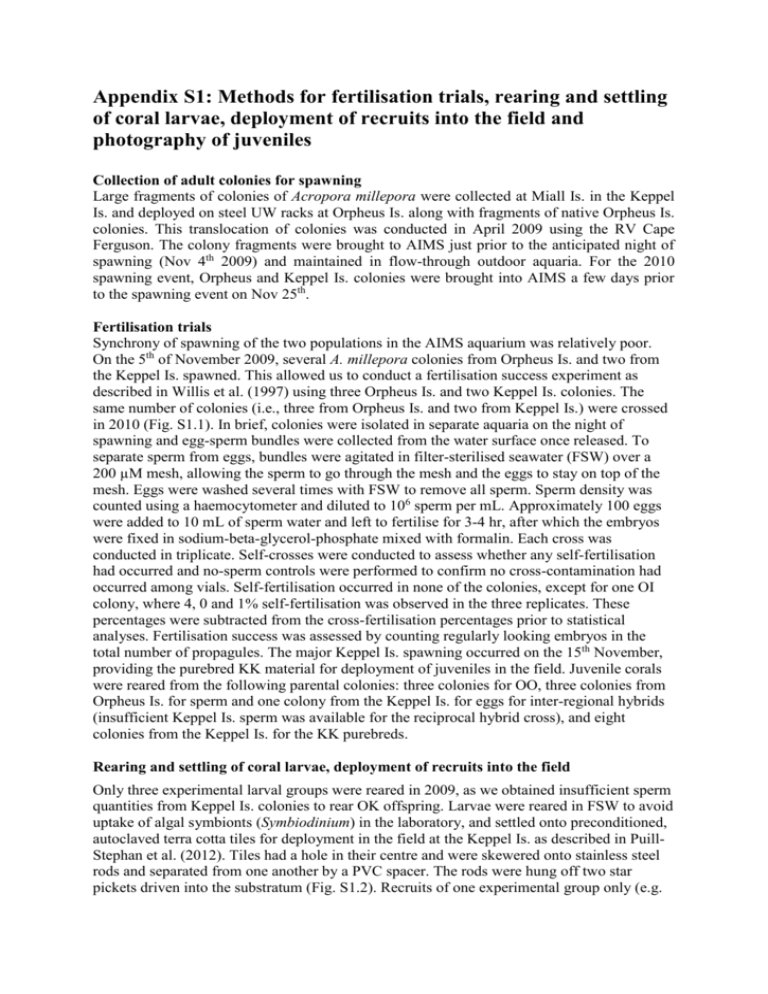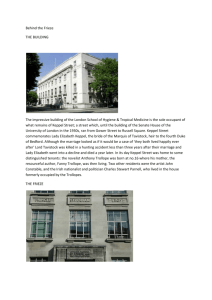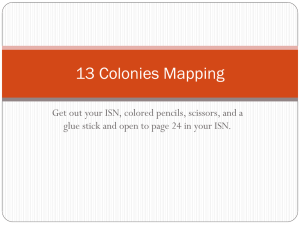Appendix S1: Methods for fertilisation trials, rearing and settling of
advertisement

Appendix S1: Methods for fertilisation trials, rearing and settling of coral larvae, deployment of recruits into the field and photography of juveniles Collection of adult colonies for spawning Large fragments of colonies of Acropora millepora were collected at Miall Is. in the Keppel Is. and deployed on steel UW racks at Orpheus Is. along with fragments of native Orpheus Is. colonies. This translocation of colonies was conducted in April 2009 using the RV Cape Ferguson. The colony fragments were brought to AIMS just prior to the anticipated night of spawning (Nov 4th 2009) and maintained in flow-through outdoor aquaria. For the 2010 spawning event, Orpheus and Keppel Is. colonies were brought into AIMS a few days prior to the spawning event on Nov 25th. Fertilisation trials Synchrony of spawning of the two populations in the AIMS aquarium was relatively poor. On the 5th of November 2009, several A. millepora colonies from Orpheus Is. and two from the Keppel Is. spawned. This allowed us to conduct a fertilisation success experiment as described in Willis et al. (1997) using three Orpheus Is. and two Keppel Is. colonies. The same number of colonies (i.e., three from Orpheus Is. and two from Keppel Is.) were crossed in 2010 (Fig. S1.1). In brief, colonies were isolated in separate aquaria on the night of spawning and egg-sperm bundles were collected from the water surface once released. To separate sperm from eggs, bundles were agitated in filter-sterilised seawater (FSW) over a 200 µM mesh, allowing the sperm to go through the mesh and the eggs to stay on top of the mesh. Eggs were washed several times with FSW to remove all sperm. Sperm density was counted using a haemocytometer and diluted to 106 sperm per mL. Approximately 100 eggs were added to 10 mL of sperm water and left to fertilise for 3-4 hr, after which the embryos were fixed in sodium-beta-glycerol-phosphate mixed with formalin. Each cross was conducted in triplicate. Self-crosses were conducted to assess whether any self-fertilisation had occurred and no-sperm controls were performed to confirm no cross-contamination had occurred among vials. Self-fertilisation occurred in none of the colonies, except for one OI colony, where 4, 0 and 1% self-fertilisation was observed in the three replicates. These percentages were subtracted from the cross-fertilisation percentages prior to statistical analyses. Fertilisation success was assessed by counting regularly looking embryos in the total number of propagules. The major Keppel Is. spawning occurred on the 15th November, providing the purebred KK material for deployment of juveniles in the field. Juvenile corals were reared from the following parental colonies: three colonies for OO, three colonies from Orpheus Is. for sperm and one colony from the Keppel Is. for eggs for inter-regional hybrids (insufficient Keppel Is. sperm was available for the reciprocal hybrid cross), and eight colonies from the Keppel Is. for the KK purebreds. Rearing and settling of coral larvae, deployment of recruits into the field Only three experimental larval groups were reared in 2009, as we obtained insufficient sperm quantities from Keppel Is. colonies to rear OK offspring. Larvae were reared in FSW to avoid uptake of algal symbionts (Symbiodinium) in the laboratory, and settled onto preconditioned, autoclaved terra cotta tiles for deployment in the field at the Keppel Is. as described in PuillStephan et al. (2012). Tiles had a hole in their centre and were skewered onto stainless steel rods and separated from one another by a PVC spacer. The rods were hung off two star pickets driven into the substratum (Fig. S1.2). Recruits of one experimental group only (e.g. OO, KO or KK) were settled on each tile, and each rod contained tiles with recruits from the same experimental group. Assessment of juvenile coral size All settlement tiles were photographed prior to deployment in the field to allow assessment of growth and mortality over time. Juveniles were deployed in the Keppel Is. on the 22nd of November (OO and OK) and the 4th of December (KK). The surface area of coral juveniles was measured in cm2 from the images taken of the settlement tiles using the software Canvas (ACD systems). Tiles were placed in a small square container with enough seawater to cover the tile and photographed using a digital camera (Canon Powershot A630), which was mounted on a tripod and zoomed at 50 mm. Each tile was tagged and recruits were monitored on one side of the tile only. Growth was adequately captured up to 4 months post-settlement because of the primarily 2-dimensional structure of coral juveniles up until that age. Figure S1.1: Design of crosses conducted between Orpheus and Keppel Island A. millepora colonies. There was insufficient sperm available to rear larvae using Keppel Is. sperm, but all crosses were conducted to assess fertilisation success. Figure S1.2: Diver deploying rods with settlement tiles containing coral recruits in the field. References Puill-Stephan E, van Oppen MJH, Pichavant-Rafini K, Willis BL (2011) High potential for formation and persistence of chimeras following aggregated larval settlement in the broadcast spawning coral, Acropora millepora. Proc Roy Soc Lond B Biol Sci 279:699-708 Willis BL, Babcock RC, Harrison PL. Wallace CC (1997) Experimental hybridisation and breeding incompatibilities within the mating systems of mass spawning reef corals. Coral Reefs 16 (Suppl.):553-565








